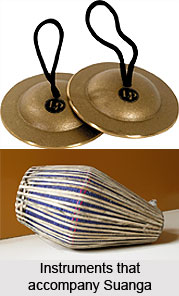 Suanga is a musical folk theatre whose literal meaning is masque or farce. This folk art was most popular in coastal Odisha till the early part of the twentieth century. It is a development over the Leelas. Although it has become extinct there, it is still prevalent in Kalahandi and Balangir districts of western Odisha. In this art form, all the characters sing, dance and act. Owing to the popularity of `Jatra`, Suanga has slowly died out.
Suanga is a musical folk theatre whose literal meaning is masque or farce. This folk art was most popular in coastal Odisha till the early part of the twentieth century. It is a development over the Leelas. Although it has become extinct there, it is still prevalent in Kalahandi and Balangir districts of western Odisha. In this art form, all the characters sing, dance and act. Owing to the popularity of `Jatra`, Suanga has slowly died out.
Themes of Suanga
The themes of Suanga mostly concern itself with stories from legends, folk lore"s, and episodes from mythologies. Sometimes, it also takes inspiration from history.
Performance of Suanga
It has all the ingredients of a Jatra, melodrama and abstract theatre. The technique of Suanga informs the spectacular Prahlada Nataka. The actors of Suanga are required to sing their own dialogue. All the characters introduce themselves through songs. For example, when Siva enters he sings, `I am Siva, God of three worlds, Ganga is in my matted locks, I live in Kailash.` While the choruses are sung, the actors dance gently. Enough humour is provided by minor characters such as the Dwari or sentry and Vaidya or village doctor. They sing and gesticulate according to the mood and meaning of the songs. Their portions of dialogue are written in common colloquial language.
Instruments of Suanga
Gini i.e. cymbals and mardala or mridanga i.e. double-ended drums are the only musical instruments that accompany this folk art form.
Noted Playwrights of Suanga
Suanga playwrights who dominated Oriya theatre with their performing troupes were Jagannath Pani, Gopal Das, Bandhu Nayak, Dayanidhi Swain, Baishnab Pani, and Balakrishna Mohanty. All later converted to Yatra because of popular demand.
This article is a stub. You can enrich by adding more information to it. Send your Write Up to content@indianetzone.com




















